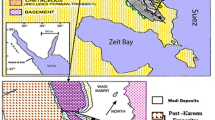Abstract
The Raman Oil Field is an east-west trending double plunging anticline located in southeast Turkey. The Raman Structure is bordered by a major reverse fault extending along the southern steep flank. The Raman anticline, as a structurally controlled topographic high, is in the foothills belt of the Taurus-Zagros mountain chains. During much of the Palozonic and Mesozoic periods, the study area was in the unstable shelf region.
The productive Mardin Reservoir Interval (Karababa “c” member) is characterized by various carbonate facies of the different subenvironments, whose development was controlled by development of the major rudist buildup in the study area. Vertical and lateral facies changes in the carbonate buildup are exhibited by the different textural kinds of limestone. These kinds include a Rudistic Framework (mound) Facies composed mainly ofin situ rudist shells that are considered to be a volumetrically important constituent based upon the models of the rudistic habitats. The Detritus Apron Facies is characterized by rudist bioclastic limestones and is volumetrically less important. The Intermound (Lagoonal) Facies is basically composed of mud-dominated limestones. Based upon established rudist buildup models, this facies is considered to be one of the major facies in the Raman Field. The Crestal Detrital Facies is characterized by relatively well winnowed (clean) granular (skeletal to non-skeletal) limestones and some mud-dominant supratidal limestones and local dolomite intercalations. This facies had a limited existence, probably the result of the long term pre-Kiradag (post Turonian) erosion. Beyond the unique occurrence of the northeasterly-lying, fairly thick biostromal limestone lens, the Garzan Reservoir is characterized by sporadic porous limestone levels developed in a sequence of argillacenous limestones and shale interbeds.
The Karababa “c” carbonates display the final results of consecutive phases of diagenesis. Chalkification, recrystallization and concurrent leaching processes created most of the present pore volume in the carbonate rocks under consideration. Dolomitization is volumetrically negligible in the Raman Reservoir Interval, contrary to the regional character of the Karababa “c” member. Fracturing (mostly tectonic) was one of the latest diagenetic factors affecting carbonates of the study area. Similar but less frequent diagenetic processes were responsible for forming the textural properties observed in the Garzan Reservoir interval.
The observed porosities can be grouped into two genetic classes: depositional and diagenetic porosity. Depositional porosities (interparticle and intra-particle) are not important in either the Mardin or Garzan Reservoir Intervals. Diagenetic porosity includes vugular, fossil and matrix moldic pores as well as micro-intercrystalline (chalky) and intercrystalline matrix pores. The matrix pores are volumetrically more important than the others. According to a newly defined “chalky” (micro-intercrystalline) matrix porosity, effective porosity and permeability are closely controlled by the existence of intercrystalline matrix pores in the reservoir rock. Dominant micro-intercrystalline (chalky) matrix pores are considered ineffective in terms of movable oil. The main influence of the fractures on the reservoir intervals is to enhance vertical permeability.
For the purpose of reservoir definition and simulation, the upper portion of the Mardin Group exhibiting reservoir characteristics was divided into three major layers (II, III and IV), while the Garzan horizons, with hydrocarbon storage capacity overlying the Mardin Reservoir interval, were included in Layer I.
Similar content being viewed by others
References
Dunham, R. J., 1962, Classification of Carbonate Rocks According to Depositional Texture,in Ham, W. E., ed., Classification of Carbonate Rocks, A Symposium: AAPG Geological Memoir 1, p. 108–121.
Erdogan, L. T., 1980, Raman Sahasi Gelistirme Raporu: TPAO Exploration Department Report.
Folk, R. L., 1962, Spectral Subdivision of Limestone Types,in Ham, W. E., ed., Classification of Carbonate Rocks, A Symposium, AAPG Geological Memoir 1, p. 62–84.
Frost, S. H., Bliefnick, D. M. and Harris, P. M., 1983, Deposition and Porosity Evolution of A Lower Cretaceous Rudist Buildup, Shuaiba Formation of Eastern Arabian Peninsula, Carbonate Buildups — A Core Workshop: SEPM Core Workshop No. 40, p. 381–410.
Gurpinar, O. andCan, C., 1983, Reservoir Evaluation Study, Raman Field, Turkey: TPAO Production Department Report.
Hemer, D. O. andLyle, J. H., 1985, Oil and Gas Developments in Middle East in 1984: AAPG Bulletin, v. 69, p. 1727–1743.
Isbilir, M., 1982, Raman Uretim Sahasinin Log Verileri Isiginda Garzan Formasyonunun Hidrokarbon Olanaklarinin Arastirilmasi ve Varilan Sonuclar: TPAO Exploration Department Report, Archive No. 1728.
Jodry, R. L., 1972, Pore Geometry of Carbonate Rocks (Basic Geologic Concepts),in Chilingar, G. V. et al., eds., Oil and Gas Production from Carbonate Rocks, New York, Elsevier, 408 p.
Keskin, C., 1967, Celikli Sahasi Karbonatlarinin Mikrofasiyes ve Diyajenez Incelemesi On ve Son Raporlari: TPAO Exploration Department Report, Archive Nos. 397 and 397/A.
Keskin, C., 1971, Sedimentary Microfacies of the Cretaceous Carbonate Rock Sequence in District V, and Their Importance in Stratigraphic Correlations,in Keskin, C., and Demirmen, F., eds.,: Proceedings, First Petroleum Congress of Turkey, p. 73–80.
Keskin, C. and Eseller, G., 1976, A Preliminary Approach to the Dolomitization of the Karababa “c” Member of the Mardin Group: TPAO Petroleum Research Center Report, Archive No. 1036.
Keskin, C., Sadler, G. M. and Stanton, P. M., 1984, Raman, Garzan B, Garzan C Reservoirs, Enhanced Oil Recovery Project, Volume II, Geology and Petrophysics of Raman Field: Scientific Software-Intercomp.
Perincek, D., 1980, Softek Antiklinalinde ve Yakin Dolayinda Mardin Grubu ile Diskondans Kapani Olasilikli Beloka Formasyonunun Petrol Olanaklari: TPAO Exploration Department Report, Archive No. 1430.
Rigo de Righi, M. andCortesini, A., 1964, Gravity Tectonics in Foothills Structure Belt of Southeast Turkey: AAPG Bulletin, v. 48, p. 1911–1937.
Author information
Authors and Affiliations
Rights and permissions
About this article
Cite this article
Keskin, G., Can, C. Upper cretaceous carbonate reservoirs of the Raman Field, Southeast Turkey. Carbonates Evaporites 1, 25–43 (1986). https://doi.org/10.1007/BF03174401
Published:
Issue Date:
DOI: https://doi.org/10.1007/BF03174401




